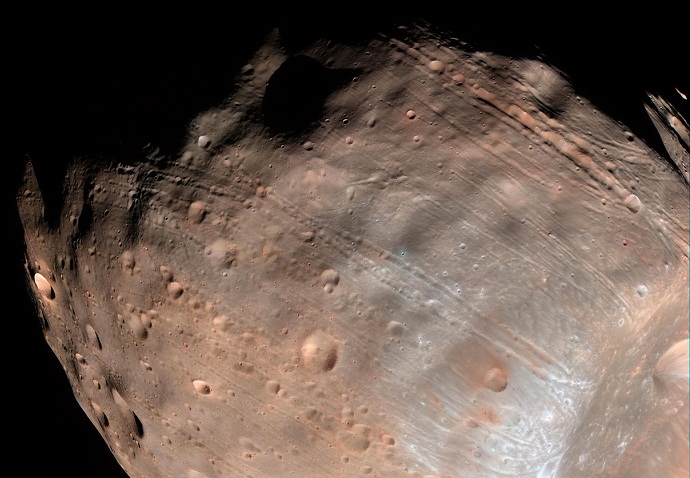The act of cosmic violence would make Mars the first rocky world in the solar system to sport a ring, the others being the gas giants Jupiter, Saturn, Uranus and Neptune.
Phobos is the largest of the two Martian moons, but the cratered, dusty rock is a mere 22km across. It orbits the planet three times a day at only 6,000km above the surface. The second Martian moon, Deimos, is about half the size of Phobos and orbits much farther out.
Astronomers who track Phobos have found that the moon edges closer to Mars by 1.8cm a year. Depending on conditions, it will start to skim the top of the tenuous Martian atmosphere in 20 to 70 million years. What has been unclear was whether Phobos would break apart in orbit or slam into the Martian landscape.
To predict the fate of Phobos, scientists at the University of California, Berkeley, gathered data on the moon’s density, its internal structure and the varying forces that wrench and pull it around, and fed them into a computer model.
One prominent feature on Phobos is the 10km-wide Stickney crater, the result of a massive impact in the moon’s distant past. The collision was not sufficient to destroy Phobos, but will have damaged material around the crater and potentially sent cracks running throughout the entire moon, weakening it considerably.
The models drawn up by Benjamin Black and Tushar Mittal show that Phobos is likely to survive its descent for a good while yet, but could start to break up in 20 to 40 million years’ time. But once Phobos starts to crumble, within six weeks it could produce a ring around Mars that holds much of the moon’s ten trillion tonnes of material. “In other words, ring formation will proceed very quickly,” the scientists write in the journal Nature Geoscience. Once formed, the Martian ring could last for a million to one hundred million years.
While damaged moon rock and lighter, more fractured material will fall off Phobos first, some denser lumps may survive the tidal forces and ultimately slam into the Martian surface. Those will not strike Mars with the force of typical asteroid and comet impacts, but come in much slower and at a shallower angle.
Earlier this month, Nasa scientists reported that channels on the surface of Phobos are probably the first outward signs of the moon being torn apart by the gravitational effects of Mars. Speaking at the Geological Society of America meeting in Baltimore, Terry Hurford of Nasa’s Goddard Space Flight Center in Maryland, said computer models of Phobos showed that the grooves had formed along the lines of greatest stress, suggesting they could be fault lines in the moon.
Spacecraft first captured images of the long grooves on Phobos in the 1970s, when the Viking and Mariner 9 probes visited Mars. Then, in 2008, the European Space Agency’s Mars Express orbiter revealed that rather than being a solid lump of rock, Phobos was actually a bundle of loose rubble held together by a stronger outer layer of material.
Black and Mittal say it will take more missions to Phobos to find out if their prediction is right. Scientists have proposed a number of discovery missions to explore the moon, including the Phobos Surveyor project, which aims to land small hedgehog-like rovers onto the moon’s surface.
More about:
















































